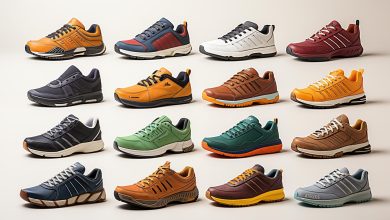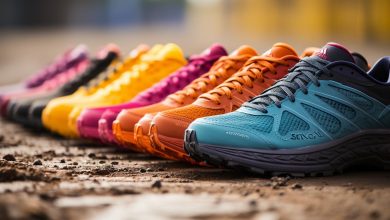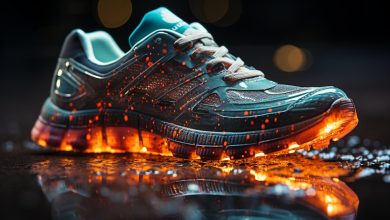Different Types of Running Shoes: Neutral, Stability, and Motion Control

Looking for the perfect pair of running shoes? Look no further!
In this article, we’ll take you on a journey through the world of different types of running shoes: neutral, stability, and motion control.
Get ready to discover the secrets behind each type and find out which one is best suited for your unique needs.
So lace up those sneakers and get ready to hit the pavement with confidence!
Understanding Neutral Running Shoes
If you have a neutral foot strike, neutral running shoes are designed to provide the right amount of cushioning and support for your stride. These shoes are specifically made for runners who do not overpronate or underpronate, meaning their feet land in a natural, balanced position when they run.
One of the key features of neutral running shoes is their cushioning. They have ample padding throughout the shoe, particularly in the midsole area, which helps absorb shock and reduce impact on your joints. This cushioning also provides a comfortable ride and allows for smoother transitions from heel to toe.
Another important feature is flexibility. Neutral running shoes typically have more flexibility in the forefoot area compared to other types of running shoes. This flexibility allows your foot to move naturally and comfortably during each stride.
Contrary to common misconceptions, neutral running shoes are not only suitable for long-distance runners or those with high arches. While it’s true that some people with high arches may benefit from additional arch support found in stability or motion control shoes, many individuals with normal arches can also find great comfort and performance in neutral running shoes.
Overall, if you have a neutral foot strike and prefer a well-cushioned and flexible shoe, give neutral running shoes a try! They could be just what you need for an enjoyable and injury-free run.
Exploring Stability Running Shoes
When choosing running shoes, it’s important to consider the level of stability they provide. Stability running shoes are designed to support your feet and prevent excessive inward or outward rolling motion, known as overpronation or supination respectively. These shoes are ideal for runners who have low arches or flat feet, as well as those who experience ankle instability.
To help you in your search for the perfect stability running shoe, here is a comparison table highlighting some popular brands:
| Brand | Cushioning | Support | Durability |
|---|---|---|---|
| Nike | Moderate | Excellent | High |
| Brooks | Plush | Good | High |
| ASICS | Ample | Excellent | Moderate |
| New Balance | Responsive | Good | High |
| Saucony | Soft | Excellent | Moderate |
Exploring shoe cushioning is essential when selecting a stability shoe. Look for moderate to ample cushioning that provides shock absorption and reduces impact on your joints. Additionally, comparing different shoe brands allows you to assess their level of support and durability. Consider factors such as the quality of materials used and customer reviews.
Unraveling Motion Control Running Shoes
Exploring the features of motion control shoes is essential for runners seeking additional support and stability. These specialized running shoes are designed to help combat overpronation, a common issue where the foot rolls too far inward during each stride.
Here are four key aspects of motion control shoes that you should know:
1. Sturdy Midsole: Motion control shoes often feature a firm and supportive midsole that helps prevent excessive pronation by providing a stable base for your feet.
2. Pronation Control Technology: These shoes employ advanced motion control technology, such as medial posting or dual-density foam, which helps correct overpronation by guiding the foot into a more neutral position.
3. Enhanced Arch Support: Motion control shoes typically offer substantial arch support to help address the flat-footedness commonly associated with overpronation.
4. Durable Outsole: The outsoles of these shoes tend to be made from durable rubber compounds, providing excellent traction and durability for both road and trail running.
Benefits of Neutral Running Shoes
The benefits of neutral running shoes include improved flexibility and natural foot movement. Neutral running shoes are designed to provide a balanced platform for runners with normal pronation, where the foot rolls inward slightly upon impact. One of the key advantages of neutral shoes is their ability to enhance your natural stride by allowing your feet to move freely in a more biomechanically efficient manner. These shoes typically have a lower heel-to-toe drop, which promotes a more natural gait cycle and encourages midfoot or forefoot striking.
In addition to flexibility and natural foot movement, neutral running shoes offer other features that can enhance your overall running experience. They often have cushioning systems that provide optimal shock absorption, reducing the risk of injuries caused by repetitive impact forces. The lightweight construction of these shoes also contributes to their appeal, as they allow you to run comfortably without feeling weighed down.
Now that you understand the advantages and features of neutral running shoes, it’s important to choose the right type for you based on your individual needs and preferences.
Choosing the Right Type of Running Shoe for You
To find the perfect running shoe for you, consider your individual needs and preferences. It’s important to remember that not all running shoes are created equal, and finding the right fit can make a world of difference in your running experience.
Here are four key factors to keep in mind when choosing the right type of running shoe for you:
1. Importance of proper fitting shoes: Properly fitting shoes are essential for injury prevention and overall comfort. Ill-fitting shoes can lead to blisters, black toenails, or even more serious issues like plantar fasciitis or shin splints.
2. Foot type: Understanding your foot type is crucial in determining the right shoe for you. There are three main foot types – neutral pronation, overpronation, and underpronation (supination). Knowing your foot type will help guide you towards the appropriate level of cushioning and support.
3. Running style: Are you a heel striker or a forefoot striker? Your running style plays a role in choosing the right shoe as it affects where impact is absorbed during each stride.
4. Common running shoe mistakes to avoid: Avoid buying shoes solely based on brand or appearance; instead, focus on fit and functionality. Don’t assume that one size fits all – what works for someone else may not work for you.
Conclusion
As you lace up your running shoes and hit the pavement, remember that the right pair can make all the difference.
Just like the different types of running shoes – neutral, stability, and motion control – each symbolize a unique journey for every runner.
Whether you’re looking for balance, support, or control, understanding these distinctions will help you find your perfect match.
So go ahead and embrace the symbolism of your footwear as you chase your goals and conquer new horizons on your running adventures.






